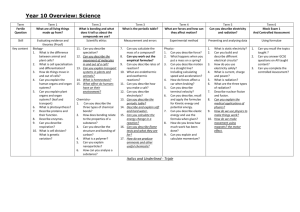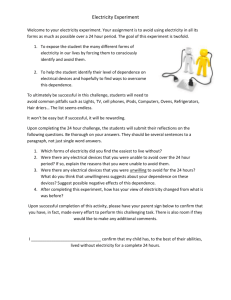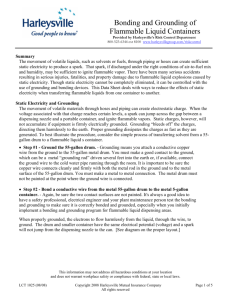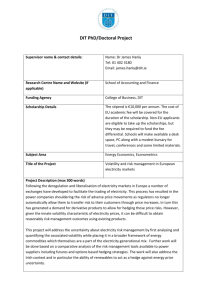BONDING AND GROUNDING OF FLAMMABLE LIQUIDS
advertisement
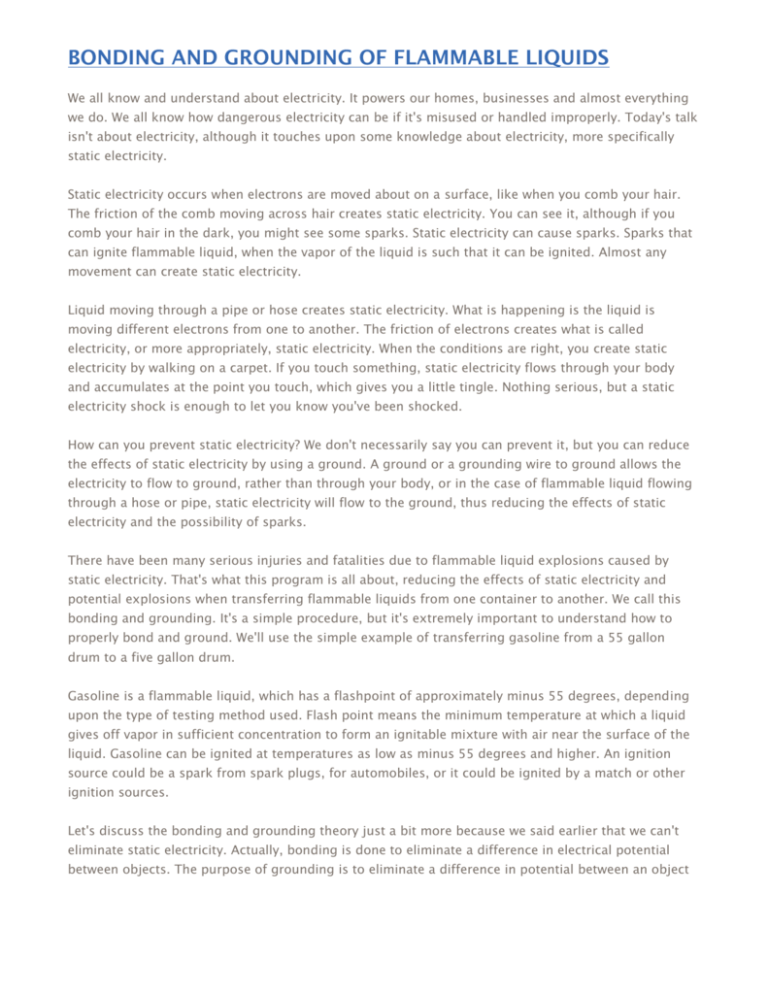
BONDING AND GROUNDING OF FLAMMABLE LIQUIDS We all know and understand about electricity. It powers our homes, businesses and almost everything we do. We all know how dangerous electricity can be if it's misused or handled improperly. Today's talk isn't about electricity, although it touches upon some knowledge about electricity, more specifically static electricity. Static electricity occurs when electrons are moved about on a surface, like when you comb your hair. The friction of the comb moving across hair creates static electricity. You can see it, although if you comb your hair in the dark, you might see some sparks. Static electricity can cause sparks. Sparks that can ignite flammable liquid, when the vapor of the liquid is such that it can be ignited. Almost any movement can create static electricity. Liquid moving through a pipe or hose creates static electricity. What is happening is the liquid is moving different electrons from one to another. The friction of electrons creates what is called electricity, or more appropriately, static electricity. When the conditions are right, you create static electricity by walking on a carpet. If you touch something, static electricity flows through your body and accumulates at the point you touch, which gives you a little tingle. Nothing serious, but a static electricity shock is enough to let you know you've been shocked. How can you prevent static electricity? We don't necessarily say you can prevent it, but you can reduce the effects of static electricity by using a ground. A ground or a grounding wire to ground allows the electricity to flow to ground, rather than through your body, or in the case of flammable liquid flowing through a hose or pipe, static electricity will flow to the ground, thus reducing the effects of static electricity and the possibility of sparks. There have been many serious injuries and fatalities due to flammable liquid explosions caused by static electricity. That's what this program is all about, reducing the effects of static electricity and potential explosions when transferring flammable liquids from one container to another. We call this bonding and grounding. It's a simple procedure, but it's extremely important to understand how to properly bond and ground. We'll use the simple example of transferring gasoline from a 55 gallon drum to a five gallon drum. Gasoline is a flammable liquid, which has a flashpoint of approximately minus 55 degrees, depending upon the type of testing method used. Flash point means the minimum temperature at which a liquid gives off vapor in sufficient concentration to form an ignitable mixture with air near the surface of the liquid. Gasoline can be ignited at temperatures as low as minus 55 degrees and higher. An ignition source could be a spark from spark plugs, for automobiles, or it could be ignited by a match or other ignition sources. Let's discuss the bonding and grounding theory just a bit more because we said earlier that we can't eliminate static electricity. Actually, bonding is done to eliminate a difference in electrical potential between objects. The purpose of grounding is to eliminate a difference in potential between an object and ground. Bonding and grounding are effective only when the bonded objects are conductive, such as a copper wire. Bonding will not eliminate the static charge, but will equalize the potential between the objects bonded so that a spark will not occur between them. Ok, we've established that flammable liquids can be ignited and we also know that static electricity can be the igniter, or ignition source. Let's now bond and ground the two containers of flammable liquid, so we can reduce the effects of static electricity and the possibility of a static electricity explosion. The first step is to ground the 55 gallon drum. Grounding means you attach a copper conductive wire to ground and to the metal 55 gallon drum. You must make a good contact to the ground, which can be a grounding rod driven several feet into the earth, or to an appropriately grounded water pipe or other approved ground. Be sure the copper wire connects solidly with the metal surface of the ground and to the metal surface of the 55 gallon drum. The metal drum must not be painted at the point where the ground wire is connected. If you're using a water pipe as the ground, this surface must also not be painted. You must make a metal to metal connection. The next step is to bond a conductive wire from the metal 55 gallon drum to the metal 5 gallon container. Again, be sure the two contact surfaces are not painted. It's always a good idea to have a Safety Professional or Electrical Engineer test the bonding and grounding to make sure it is correctly bonded and grounding, especially when you initially implement a bonding and grounding program for flammable liquid dispensing areas. When you have a properly grounded drum and a properly bonded smaller container, both bonded and grounded containers permit the electrons to flow in, the liquid to go to ground, thus eliminating sparks from static electricity. When you fill up your automobile's gas tank, why don't you have to bond and ground? Basically, you are bonded and grounded. The station's main tank and pump are grounded and the connection of the metal nozzle touching the gas tank forms the bond between the automobile and the gasoline pump. Anytime you're transferring flammable liquid, any flammable liquid, you should bond and ground to eliminate the possibility of an explosion from a static electricity spark. It doesn't take a big spark, even a tiny spark that can't be seen by the human eye can ignite flammable liquid, if all the conditions are right. It takes the right amount of vapor mixed with air, but it can happen as it has so many times in the past. Don't take chances! Use bonding and grounding for your protection as well as the protection of others and of course, the assets of the organization. Flammable liquid flowing through pipes and hoses are not the only causes of static electricity. Anything that can move electrons creates static electricity, such as steam lines, v belts, agitators, conveyor belts and so on. Make sure all transfer hoses and nozzles are clean, because rust, dirt or other non- conductors in the flow can create electron flow and static electricity. Always inspect your bonding and ground wire for broken or separated conductors. Bonding and grounding systems should be checked regularly for electrical continuity. Many organizations recommend the use of bare-braided flexible copper wire because it facilitates inspection and prevents broken wires from being concealed. Bonding and grounding is a simple process, but it takes some effort and diligence on everyone's part to make it work. It's a life saver.





